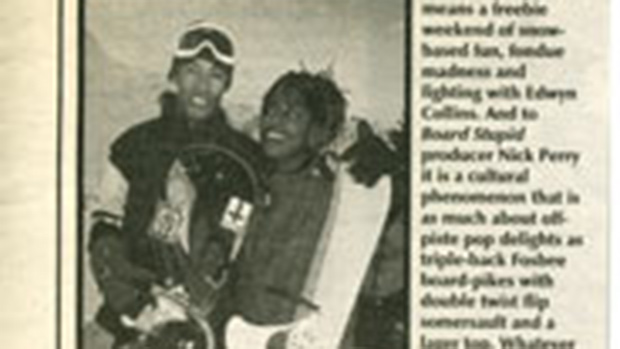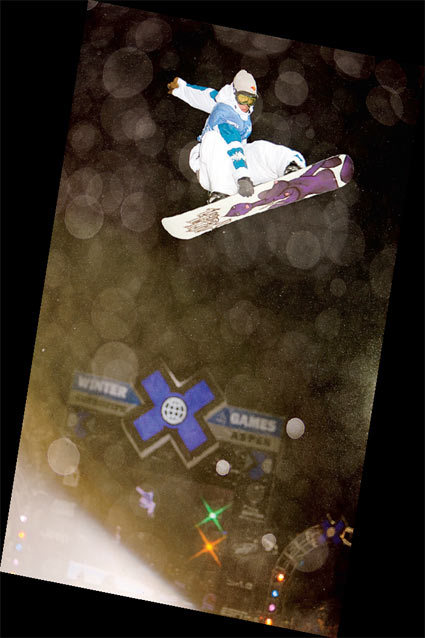Words: Sandy Stevenson
Photography: Jeff Curtes
“Leave it as it is… The ages have been at work on it, and man can only mar it.”
Theodore Roosevelt (26th President of United States)
To get to South East Greenland, you must first fly to Reykjavik in Iceland and then hop a further two hours west across the ocean. Outside the window, ice floes like broken confetti litter the blue, open seas of the North Atlantic, then give way to bigger, snow-covered icebergs as the sea thickens into a white sheet around the coastal islands of Greenland. From above, these giant ‘bergs look little more than coagulated lumps sugar, but in reality these are ancient and sometimes gigantic formations – the ones in Greenland can reach the same height as a 55-story building and weigh up to 200,000 tonnes. Still marvelling at their frosty features and wondering if they held any snowboarding secrets, we landed on the tiny dirt-track runway at Kulusuk – a relatively ice-free outpost that serves as heli-hub to the tiny communities of the neighbouring islands.
Two days prior to our arrival, they’d shot dead a polar bear a few hundred yards from the terminal building. It’s stories like these you start to hear the minute you arrive in Greenland, along with tales of discovery from the many expedition leaders and scientists waiting for transfers from the airport. Then it strikes you: people are coming here to find wilderness or to study climate change – to gain an extreme experience in the true sense of the word. So, as an ex-marine standing beside me rambled on about guiding rich businessmen across the ice cap, I looked around at our crew – dressed in skate trainers and jeans – and wondered if we were prepared. Shrugging off equipment concerns, we boarded the Air Greenland helicopter for our final transfer, which whirred and chopped its way to one of the remote villages – Tasiilaq, a 20 minute ride from the airport.

Nestled above a natural harbour, Tasiilaq (population 1700) is an Inuit settlement. Football-mad children run riot around the village square while husky dogs howl out for their dinner. The new tourist office stands proudly in the centre, a positive sign of the town’s growing economy. Elsewhere, bright red houses are propped up above the near-permanent snow cover and fishing boats lie dormant in the ice-locked harbour, waiting for summer to set them afloat once more. This is a thriving community with a growing population as tourism expands steadily, bolstering the local economy. Some of the Inuit still supplement their incomes with hunting (mostly seal, sometimes polar bear) while a third derive part-time income from their sculpture, carving and printmaking. There are a couple of hotels, some supermarkets and a bar. More importantly, there is a medium-sized iceberg just 200 yards from the centre of town, which is where our crew headed for the first ever iceberg tow-in session.
Icebergs have an interior temperature of -15 to -20°C, so it’s no wonder these things are sometimes eons old. It also means that they are hard as hell – to say riding one was sketchy is an under-statement. As we gingerly walked around on the ice we could here a fizzing sound; this is called ‘Bergie Seltzer’, the sound of an iceberg melting as the compressed air bubbles inside begin to pop. This didn’t phase Nicolas or Terje, who hand-planted away while the film camera whirred in the quiet and Jeff’s camera clicked continuously. It was a session the likes of which not many people will ever experience. Not content with gambling limb breakages on this rock hard lump of blue ice, the boys then decided to use the iceberg closer to Tasiilaq as a tow-in feature – because as icebergs go, it had more varied terrain. Mads found a wall to power-slash against while Terje and Nicolas used a ridge to boardslide and jib on. The masters of creativity were laying into this icy edifice with gusto, and as the snow flew skywards and surf-style board snaps were caught on film, the now-familiar dinner time howl of husky dogs resumed from the town. It wasn’t long before we needed to refuel as well.
Eco-Boarding“When one tugs at a single thing in nature, he finds it attached to the rest of the world.”
John Muir (1838-1914)
After the tomfoolery of the berg-shredding, a new idea was hatched. The plan was to use teams of dog-sleds to venture into the mountains, granting the crew access to virgin snowboard territory. A camp would be set up in remote huts normally used by mountaineers in summer, or by Inuit hunters seeking refuge from the extreme cold in winter. This being late April we were somewhere between the two. Camp life would still be harsh at this time of year (-20 C overnight) but with arctic-condition sleeping bags, a sat-nav phone, a few bottles of red wine and a deck of UNO cards packed in with the Therma-Rests, we were confident we would manage fine. Besides, we would have a crew of Inuit dog-mushers with us – these guys are used to hauling 800 kilo sleds across the Greenland ice cap in mid-winter. Our own team leader was a man called Dines Mikaelson, a swarthy Inuit with a beaming smile. Together with his crew of seven mushers, they brought a total of 86 dogs (with anywhere between ten and fifteen dogs in a pack). It seemed an apt mode of transport given that two of our group – Terje Haakonsen and Mads Jonsson – were Norwegian; it was dog sleds that the Norwegian explorer Roald Amundsen had used in his expedition to reach the South Pole.

And so we set off northwards across the frozen fjord, in the general direction of the ice sheet. The dogs yelped their way into action while the dog mushers urged them on over the frozen water. It’s a combination of actual words and gutteral noises that make up the line of communication between dogs and musher. Together with some strategic shunting and weight-shifting of the sled, this is how you get from A to B. One minute you’re jumping off the sledge, hiking by the side and helping push your wooden ‘komatik’ up the steeper inclines, the next you’re leaping back on as the load gathers speed and momentum down the hills. Miss this leap and you’ll be running downhill after the accelerating sled! Then, as the musher claws at the snow – scrubbing off speed with a metal brake – the dogs push on, seemingly more thrilled than you are at hurtling down the mountainside. Snow flies in your face, taking you back to the first time you went sledging as a kid; this is exhilarating stuff and totally addictive.
As we sped along, everyone eagerly assessed the surroundings for shred-possibilities. The terrain varied from Tahoe backcountry to mid-size Alps. There were features everywhere – loads of wind-lips, gulleys like natural halfpipes and more glacier walls than you could shake a musher’s whip at. Up and up we glided through the system of valleys, passes and frozen lakes, avoiding boulders the size of apartment blocks strewn in the valley. Everywhere you looked, there were signs of glacial geography – if you were a geology-loving snowboarder then this would be heaven for you.
Camp Life“There is a delight in the hardy life of the open” Theodore Roosevelt
Our accommodation in the backcountry consisted of three wooden huts located beside a river. With low surrounding mountains of about 3000 feet, plenty of granite around and even some heather, you’d be forgiven for thinking you’d woken up in Scotland. But then a husky-dog howl later, and a wander round the corner to see glaciers and frozen lakes, and you remember you are in fact at 67 degrees north, on the east coast of the planet’s largest island.
After our day sledding, it was time to settle down for some card games and conversation. On a trip like this it’s always fascinating to see how different nationalities interact – the humour, the mannerisms, the banter. Our group comprised of three Americans, two Norwegians, one Swiss, one Canadian and two Brits. When an American started snoring in the hut and one of the British guys very politely asked him to stop the difference was plain! The solution to this problem was to ask the snorers to pitch their own tent on the frozen lake – not as bad as it sounds, but with the overnight temperature hitting about –20 C we were glad of our four-season Ajungilak sleeping bags. These were developed by Norwegian explorers and are so good that, when the wind dropped completely on the second night, a few of us moved our mats outside to sleep under the stars. The sun comes up at about 2.30am so there’s only an hour or so of actual darkness – well, more like dusk – which means you can sleep the rest of the ‘night’ away in the warmth of the arctic sun. In fact by 7 in the morning, with the sun already high in the sky, this was a ‘shirt-off /leg-out/sweatin’ bullets’ type sleeping experience.
 Into the Unknown
Into the Unknown
“I think over again my small adventures, my fears, these small ones that seemed so big. For all the vital things I had to get and to reach. And yet there is only one great thing: to live to see the great day that dawns and the light that fills the world.”
Words from an Inuit Song
Morning duties saw Kevin Pearce taking a (very!) brisk wash in the ice-cold melt-water by the side of the river, before hauling a 40 litre container of water back to the cooking area. Meanwhile Nicolas stirred the food and the mushers harnessed the dogs. And for breakfast? The only way to fuel for a day of dog-sledding, hiking and powder turns is with porridge – big, steaming plates of the stuff. Buff (our trusty mountain-guide) taught us a trick to make it a more interesting dish: load in handfuls of dried fruit – cranberries, raisins and apples. Delicious! Eating this healthy meal with a view of glaciers and snowy peaks, we had a pure moment of ‘life doesn’t get any better than this’.
As we savoured our porridge, the Inuit guys shackled the dogs to their harnesses. Mads helped out. Handling these creatures involves a careful system at all times: dogs are tied up for their overnight rest in a sequence – the same order in which they are harnessed to the sled i.e. the youngest and least-strong go near the back, working up through experience and strength to the two lead dogs at the front. Mads helped Dines unhook the dogs from their resting shackles and put them into their individual harnesses; this involves dragging them to their sled positions, starting at the back with the young dogs. These first hounds are certainly energetic and eager, but totally manageable – if there’s any sign of unruliness then a sharp tug or a strongly-voiced command is enough to quell rebellion. It’s a different story when you get to the lead dogs – these are clever and supremely strong, with the type of character needed to lead a dozen other dogs through tricky terrain, all the while communicating with the musher. When you handle a dog like this you feel its strength; the hind legs are sheer muscle and power. These are animals that are used to trekking and running 40 kilometres a day in severe weather conditions, pulling sleds of up to 800 kilos.

Always eager (and crapping everywhere!) the dogs howled out to get going as soon as they were harnessed. Pro snowboarders, while maybe less vocally eager, were soon ready too – keen to check out the riding possibilities. Off we mushed, the metal runners of the sleds zipping along through the morning crust. What a way to go snowboarding! No engines, no gas fumes, no piling kit in and out of helicopters… This was a truly natural experience, and one much richer for it. Travelling this way you are are more connected to your environment. You have a chance to hear the sounds around you (in this case, hundreds of dogs’ feet padding quickly through the snow), to see the colours of the rocks and the snow, to feel the snow… There was also more time to stop and check out gradients and features, to talk together about the possibilities and plans out lines. At one point we stopped at the summit of a pass with a clear view over the most unmissable feature of Greenland’s geography: the awesome ice sheet. This is a stunning feature to behold. The icy behemoth covers 677,676 square miles and is the second largest ice body in the world, after the Antarctic ice sheet. It is about 1500 miles long by 680 miles wide (at its widest point), and is generally more than a mile thick. It is massive by any definition of the word, not to mention ancient, at 110,000 years old. But the big question is… is it melting? Of course it naturally melts and freezes according to the seasons, but recently fears have grown that the ice has begun melting faster than it can re-generate. If it is, then there could be trouble ahead. Some scientists believe that global warming may be about to push the ice sheet over a threshold where the entire sheet will melt in less than a few hundred years. If this happens, the resultant sea-level rise would be enough to inundate most coastal cities in the world. This is a reality check we need to take seriously; maybe it’s time for us all to re-think our snowboard trips? How we get there, whether we need a helicopter, and so on.
Taking in the magnificence of the ice sheet is spellbinding, and for a while we were distracted from the task at hand – finding features to ride. Before long though, we reached the edge of a glacier, where its tongue halted against a frozen lake. Right in the centre of this glacier we spotted a giant fissure, a window into the depths of its cold, blue heart. This would be the perfect spot for some interesting shots, and so the guys began to hike up and grab some air against this dramatic backdrop.
The landing was made up of lumps of snow that had fallen off the front of the glacier – a kind of sketchy natural transition down to the frozen lake. Nicolas tested the jump with a straight air over the gap. As he took off, a husky-dog uncurled in the snow and chewed on a piece of dried seal, then dozed off again. Ears soon pricked up however when word went out Mads wanted to try a backflip. This was a sketchy plan to say the least, not just because of the dodgy landing but because the ice on the run-out over the lake looked like it would give way at any moment. Undeterred, Mads struck a balance between grace and guts as he sailed upside down over the gap and stomped in the slushy stuff. The soft snow helped him lose some speed but not quite enough to stop him from sinking knee-deep into the lake. Kevin Pearce followed, and with the skill that’s seen him tear apart most of the competitions he’s entered this year, landed some smooth methods and 540s.

Over in the far corner, Terje found a zig-zag angle to approach the edge of the glacier, leaving his graceful mark on a slope previously untouched by any snowboard. Two months previously – when he broke the quarter pipe world record – it was more a matter of inches; today his landmark was measured in degrees – 67 degrees north to be precise, the latitude of this icy wonderland. Peachy snow and jagged peaks in the background made for some picture-postcard snowboarding; but hell, with Terje at the controls it would have looked great anyway.
With drenched feet, hungry dogs, some bemused Inuit dog-mushers and one happy photographer, the crew made for camp. This was a time to slash around in the sugary snow of the twilight hours. Wind-lips here, natural gulleys there, and not a soul to be seen for miles around – just the sound of a snowboarder’s hoot echoing down the empty valley. We followed the twisting river’s course as it wound back to the huts, then feasted on boiled chicken and rice. The dogs looked on enviously as they wolfed down their protein pellets. Everyone grinned. Nicolas summed up the mood: “One of my top three trips ever, for sure.” Mads agreed, “Best trip ever.” Words not used lightly by seasoned travellers like these two. Then the pack of cards came out, a couple of candles were lit, drinks were poured and the light outside grew dim. We hunkered down for the night, as outside in the still arctic night a husky-dog howled.
GREENLAND – HOW TO GET THEREFLIGHTS
IcelandAir flies from Glasgow to Reykjavik 4 times a week, with return fares from £200
Flights from Reykjavik to Kulusuk (in East Greenland) are available through Air Iceland. These go 3 times weekly (Mondays, Wednesdays, Saturdays)
Tel: (+354) 570 3030
To book helicopter transfer from Kulusuk to Tasiilaq contact Air Greenland
Total journey time (weather permitting): approx. 10 hours
WHERE TO STAY
Robert’s Place, a 2-level house in Tasiilaq, has 1 double room with en suite, another double room and 3 twin rooms. For prices and reservations email [email protected] or Tel: +299 98 10 52.
DOG SLED HIRE
We hired dog sled crews locally from Mikaelson Tours ([email protected] or Tel: +299 98 21 43)
MORE INFO
For tourist information on Tasiilaq and surrounding area contact Destination East Greenland +299 982243 or visit eastgreenland.com



